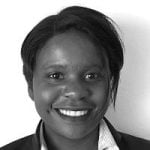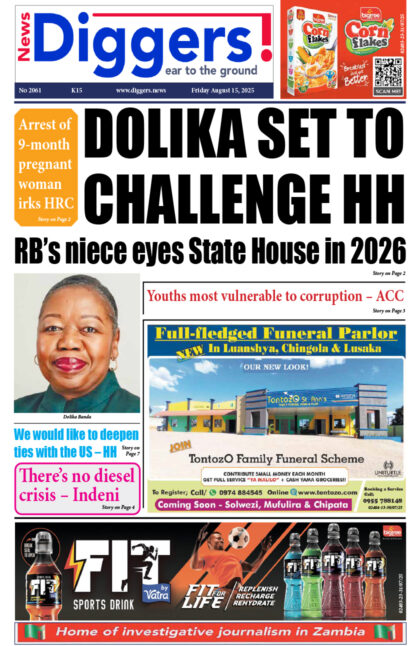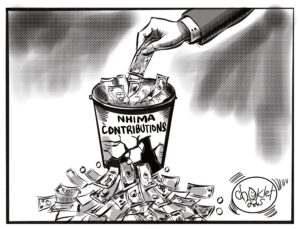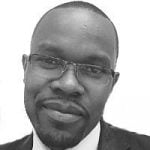DETERMINATION. Fortitude. Willpower. Grit. All words describing Zambians on election day. Air thick with anticipation, there was no telling who would emerge victorious in the August 12 elections. Multitudes of voters assembled in various locations with a common goal–to make their vote count.
Some geared themselves with food, chairs and even laptops while they braved the longest queues Zambia had ever seen on an election day. Their resolution was to make change happen. That? They absolutely did.
President- elect, Hakainde Hichilema was previously mocked by the outgoing government for being ‘social media famous’ with no chance of winning elections. This proved to be an outright underestimation of the power that Zambian youths, a majority of social media users, hold in this country.
The younger demographic of voters demonstrated in this year’s elections that they will call the shots on who will be given the mandate to rule the nation. And they did. Hakainde Hichilema, the social media’s ‘Bally’ carried the day.
But how soon is too soon to hold President Hichilema and the UPND party to all their promises? Was it all campaign flattery to tickle the fancy of the Zambian people? Issues such as the dollar rate, policy reforms, fiscal prudence, cadres and much more were discussed during the campaign leaving lingering questions on whether Zambians should prepare for a ‘nothing but up from here’ series of events or if, as a matter of fact, they will be in for a rude shock.
Economist Professor Oliver Saasa attempts to answer some of these questions and gives Zambians a possible head-start on what to expect from the President-elect once he takes the reins.
Speaking during a recent Oxfam supported ‘Our Zambia’ television discussion which airs on Diamond TV, Saasa demonstrated a sliver of hope in the currency for the next five years.
“If the price of copper is sustained at the current level and there is no reason why it shouldn’t for the next year or so. Looking at the demand for alternative energy especially in the motor sector industry, we are perhaps looking at a fairly stable, good strengthened currency. But one has to understand that, because much of this is based on export activity and especially export activity that is not diversified, that is dependent on one commodity, copper as a major source of our export receipts we are vulnerable because if something happens at a global market then we are in dire straits – this is where one has to look at alternative ways of expanding and sustaining this good price on the global market. But of course, we have to realise that a good price is only relevant to Zambia if we are able to feed in the global market raw materials,” he said.
Saasa further explained that it was necessary to work towards GDP growth as a country in order to see issues such as taxing in the mining sector remedied.
“Right now, there is a big impasse between the Zambian government or the outgoing government in the mining sector with respect to the mining tax regime. One thing we need to look at is let us have a hospitable policy environment especially on the tax segment in the mining sector but let us also diversify. Because it is through GDP growth which is not doing very well where we can start thinking of how can bally fix it. We also need external stimulus and getting the IMF on board,” said Saasa.
Economist Chibamba Kanyama adds that bringing back professionalism in the civil service was crucial for the country’s return of fiscal stability.
“Some things will be fixed quickly; it depends on the issues,” he says. “I believe fiscal stability will be achieved within a year. There are other low-lying fruits such as professionalism in the civil service. [This] will bring back the integrity of institutions that in my opinion were highly compromised,” he explains.
“I know it will be very easy to inspire confidence which is already getting to the investors out there. The next budget of 2022 will have a good share of direct donor support which we have lacked in the past seven years. But there are others that will take quite long. We must be very fair,” said Kanyama.
Yusuf Dodia, Private Sector Development Association (PSDA) Chairperson argues that a huge turn up of young people that voted were inspired by HH’s promise to fix the economy.
“If you look at the voting turnout, 70 percent of registered Zambia voters turned out to vote, that is a high percentage. Out of that percent, 61 percent voted for the UPND to form a government. If you look at the 61 percent, these are people saying ‘we are young people coming out of school, we can’t get jobs, we can’t start businesses, we don’t have access to finance.’ And across all the young people, the big challenge was, we can’t afford to survive in this economy with the cost of mealie-meal, sugar, cooking oil and so forth. So of course, in these 365 days, we need to see how we can see prices down,” said Dodia.
The president-elect and UPND therefore do not have time to “party” because a huge responsibility awaits them. They need to fix the economy, restore good governance and bring back donor confidence.
#OurZambia is a Civil Society Poverty Observatory Group and Oxfam governance platform that brings citizens and experts together to share knowledge, experience and speak to power on issues affecting the nation. To join the conversation, follow the link below:
https://web.facebook.com/watch/live/?extid=NS-UNK-UNK-UNK-IOS_GK0T-GK1C&v=3009666835946694&ref=watch_permalink
























